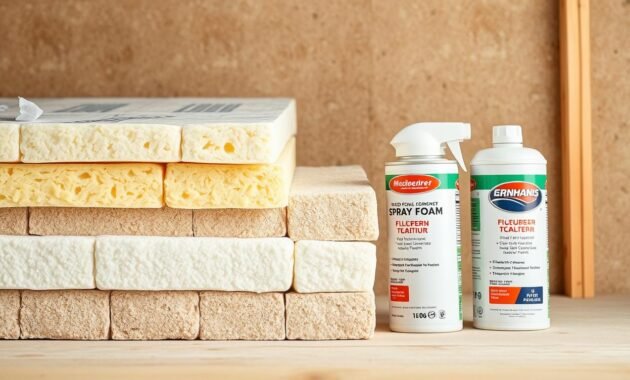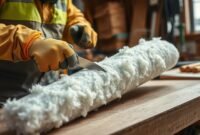Do you struggle with temperature control in your pole barn? Many people face uncomfortable and inefficient spaces. These spaces waste energy and money.
Extreme temperatures can make your pole barn unbearable. It gets too cold in winter and too hot in summer. This leads to costly heat loss and uncomfortable heat buildup.
Finding the best insulation for pole barn spaces is key. I’ll show you top insulation solutions for efficient heating and cooling. Whether you need to upgrade your ceiling or walls, the right insulation makes your space comfortable and energy-saving.
Let’s look at effective ways to keep your pole barn comfortable all year. Smart insulation strategies protect your investment and improve building performance.

Understanding Pole Barn Insulation Fundamentals
Creating an energy-efficient pole barn starts with knowing the basics of insulation. The right insulation for metal building walls and roofs is key. It greatly affects your building’s comfort and energy use.
Heat Transfer Dynamics
Heat moves in three main ways: conduction, convection, and radiation. In a pole barn, these methods can change your building’s temperature and energy use. The best insulation for pole barns blocks these heat transfers well.
- Conduction: Direct heat transfer through solid materials
- Convection: Heat movement through liquids and gases
- Radiation: Heat transfer through electromagnetic waves
The Critical Role of R-Value
R-value shows how well insulation works. It measures how well a material stops heat flow. The higher the R-value, the better insulation keeps temperatures steady. Always look at R-value when picking insulation for metal building roofs.
Read also: Foam Board Pole Barn Insulation Pros and Cons
Moisture Management Strategies
Insulation isn’t just about keeping temperatures right. It also needs to manage moisture. Vapor barriers are key to stop condensation and protect your barn’s structure. They keep insulation dry and working well.
| Insulation Type | Average R-Value | Moisture Resistance |
|---|---|---|
| Fiberglass Batts | 3.0-4.3 per inch | Moderate |
| Spray Foam | 6.0-7.0 per inch | High |
| Cellulose | 3.6-3.8 per inch | Low |
Benefits of Properly Insulating Your Pole Barn
Insulating your pole barn ceiling is key to its performance and efficiency. It’s not just about keeping it warm or cool. It’s a smart move that offers many benefits.
Energy efficiency is a big plus of insulating your pole barn. It creates a thermal barrier, reducing heat transfer. This means lower energy bills and less wear on your systems. The right insulation can save you up to 30% on energy costs.
- Significant energy cost reduction
- Improved temperature regulation
- Enhanced structural protection
- Increased building durability
Choosing the best insulation for your pole barn is more than saving money. It also protects against moisture damage and keeps the environment stable. This helps your building materials last longer and makes your workspace more comfortable.
Insulating your pole barn right depends on your needs. Different materials, like spray foam and fiberglass batts, have their own perks. Pick one that fits your climate, budget, and how you’ll use the barn.
Investing in quality insulation does more than protect your building. It makes it more efficient, comfortable, and durable. This adds value to your property.
Best Insulation for Pole Barn: Top Material Choices
Choosing the right insulation for a pole barn is key to saving energy and staying comfortable. I’ll show you the top picks for insulating pole buildings and metal sheds.

Can you insulate a pole barn well? Yes, you can! The trick is picking the right insulation for your needs. Let’s look at the most popular options for insulating pole buildings.
Fiberglass Batts and Rolls
Fiberglass is a favorite among pole barn owners. It’s affordable and has many benefits:
- Affordable pricing
- R-values from R-11 to R-30
- Easy to install for DIY fans
- Available at most home improvement stores
Spray Foam Solutions
Spray foam is great for metal shed walls. It’s a top choice for its:
- Superior air sealing
- High R-values up to R-7 per inch for closed-cell types
- Excellent moisture resistance
- Stronger structure
Cellulose Insulation Options
Builders who care about the environment like cellulose insulation. It’s eco-friendly and offers:
- Made from recycled materials
- R-value of about 3.5 per inch
- Great sound dampening
- Natural fire resistance
Each insulation type has its own advantages. The best one for you depends on your pole barn’s needs, budget, and performance goals. It’s wise to talk to a pro to find the perfect fit for your project.
Essential Considerations for Pole Barn Ceiling Insulation
Insulating pole barn walls and ceilings is key. Ceiling insulation keeps your barn warm in winter and cool in summer. It makes your barn a cozy place.
Good ceiling insulation stops heat from escaping. Heat goes up, so without insulation, your barn loses a lot of heat. It’s important to think about a few things when insulating your ceiling.
- Evaluate the R-value requirements for your specific climate zone
- Select insulation materials that provide optimal thermal performance
- Consider moisture control and ventilation needs
- Assess the compatibility of insulation with your existing barn structure
Choosing the right insulation for your pole barn ceiling depends on several things. Your budget, the weather, and how you use your barn matter. Spray foam and fiberglass batts are good options, each with its own benefits.
Getting a pro to install your insulation is a smart move. They ensure it’s done right, which saves energy and prevents moisture problems.
Learning about ceiling insulation options will help you make your pole barn better. It will be more comfortable and save energy, meeting your needs well.
Wall Insulation Techniques and Materials
Choosing the right insulation for pole barn walls is key. It’s important to know the different ways to install it. I’ve learned that good insulation keeps your space warm and cozy.

When picking insulation for pole barn walls, several things matter. The right choice can make your building more energy-efficient and last longer.
Proper Installation Methods
Getting insulation right means paying attention to how you install it. Here are the steps I suggest:
- Measure wall cavities precisely before selecting insulation
- Clean and prepare wall surfaces thoroughly
- Cut insulation materials to fit snugly between framing members
- Ensure complete coverage without compression
Avoiding Common Installation Mistakes
Many people make mistakes when insulating metal building walls. Here are some common errors to watch out for:
- Leaving gaps that compromise thermal efficiency
- Improperly sealing edges and corners
- Neglecting proper vapor barrier installation
- Using damaged or compressed insulation materials
Vapor Barrier Placement
The vapor barrier is a key part of pole barn wall insulation. I suggest putting it on the warm side to stop moisture buildup.
| Insulation Type | Vapor Barrier Recommendation | Best Use |
|---|---|---|
| Fiberglass Batts | 6-mil polyethylene sheet | Standard pole barn walls |
| Spray Foam | Integrated moisture barrier | Metal building walls |
| Rigid Foam | External vapor barrier | High-moisture environments |
By using these methods, you’ll get the best insulation for your pole barn walls. This will make your space more energy-efficient and comfortable.
Cost Analysis of Different Insulation Options
When looking at insulation for pole barns, knowing the costs is key. High-quality insulation might seem pricey at first. But, it can save you a lot of money later on.
The cost of insulation for pole barns varies from $1.00 to $4.50 per square foot. Different materials have different prices and performance. Here’s a look at the main cost factors for insulating a pole barn well.
- Fiberglass Batts: Most budget-friendly option
- Lowest cost per square foot
- Easy DIY installation
- Spray Foam Insulation: Premium solution
- Higher initial investment
- Best energy efficiency
- Costs approximately $0.60 to $2.90 per board foot
- Cellulose Insulation: Eco-friendly middle ground
- Moderate pricing
- Good thermal performance
When picking insulation for pole barns, think about more than just the initial cost. Consider the long-term energy savings. Spray foam, for example, might be pricier at first. But, it insulates better, saving you on heating and cooling costs.
Pro tip: Always get quotes from several sources. Also, look at the R-value of insulation materials. Remember, the cheapest option isn’t always the best for keeping your pole barn comfortable and dry.
Read also: How To Easily Insulate Your Walls
Professional Installation vs DIY Approaches
Choosing how to insulate a pole barn is a big decision. You can do it yourself or hire experts. Each choice has its own benefits and challenges that affect your project’s success and quality.
Several factors influence your decision. Your skills, time, and budget are key. They help decide if you should insulate the ceiling and walls yourself or hire a pro.
Tools and Equipment Needed
For a DIY insulation job, you’ll need certain tools:
- Protective safety gear (respirator, gloves, safety glasses)
- Measuring tape and utility knife
- Staple gun and staples
- Ladder or scaffolding
- Insulation cutting tools
Safety Considerations and Best Practices
When insulating pole barn walls, safety comes first. Always wear the right protective gear and follow the insulation material’s guidelines.
| Safety Aspect | Recommended Practice |
|---|---|
| Personal Protection | Full-body coverage, respirator, protective eyewear |
| Material Handling | Follow manufacturer’s safety instructions |
| Work Environment | Ensure proper ventilation, clear workspace |
Timeline and Project Planning
Good planning is key for a smooth insulation project. Insulating a pole barn can take a weekend to several days. It depends on the barn’s size and how complex it is.
- Assess your skill level and available time
- Create a detailed project timeline
- Purchase all necessary materials in advance
- Plan for any unexpected challenges
DIY can save money, but pros know the best ways to insulate. They use advanced techniques for better energy efficiency.
Maintaining and Upgrading Pole Barn Insulation
Keeping your pole barn’s insulation in good shape is key for energy savings. I’ve worked with many insulation types. Regular care makes a big difference in keeping your barn warm or cool.
It’s important to check your insulation often. I suggest doing this at least twice a year. Focus on these key spots:
- Look for signs of moisture damage
- Check for pest intrusion or nesting
- Inspect for compression or settling of insulation materials
- Examine vapor barriers for tears or gaps
Preventing problems is better than fixing them later. Small issues can turn into big expenses if not caught early. Pay close attention to areas around roof penetrations, windows, and doors.
Upgrading insulation doesn’t always mean replacing it all. Sometimes, a few tweaks can make a big difference:
- Add additional layer of spray foam in problematic areas
- Seal any visible gaps or cracks
- Replace compressed or damaged insulation sections
- Install additional vapor barriers if needed
If you’re on a budget, start with small upgrades. Focus on the most important areas first. Good insulation saves money on energy costs over time.
Conclusion
Exploring pole barn insulation shows how important it is for your building. Choosing the right insulation is more than just keeping it warm or cool. It’s about protecting your investment and making your space comfortable.
When picking insulation for your pole barn, think about energy savings, moisture control, and durability. The right material can cut down on heating and cooling costs. It also stops damage from moisture and temperature changes.
The best insulation for pole barns varies based on your needs, budget, and local weather. You might choose spray foam, fiberglass batts, or something else. Always go for professional installation and use a vapor barrier to get the most out of your insulation.
By following this guide, you can make your pole barn energy-efficient and cozy. Your careful insulation choice will save you money, keep you comfortable, and protect your building.


